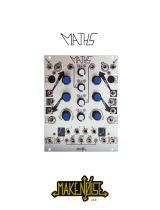Page is loading ...

+MIRROR Unipolarinverter
MANUAL
Version 1.00
FLAME

Manual FLAME MIRROR Version 1.00
Contents
1. Short description................................................................ 3
2. Hardware / connections..................................................... 3
2.1 Connection to the modular system (Doepfer bus) 3
2.2 Module overview 4
3. Handling ........................................................................... 5
3.1 Function 5-6
4. Appendix and technical informations .............................. 7
4.1 Technical details
4.2 Warrenty
4.3 Terms of production
4.4 Disposal
4.5 Support
4.6 Acknowledgment
2

1. Short description
The module is an inverter for exclusively positive voltages. It inverts an applied positive volta-
ge so that the maximum value becomes zero and zero becomes the maximum value. The input
voltage is therefore not inverted into the negative voltage range (mirror axis 0v), but reflects a
positive voltage around an adjustable axis within a fixed positive voltage range from 0v.
There are 10 ranges, adjustable in 1V steps. The mirror axis is always on half of the set range.
Negative voltages cannot be inverted with this module. Applied negative voltages are limited to
approximately zero volts.
The module has two identical function groups.
Applications are, for example, the inversion within positive voltage ranges, GATE inversions
(0/+5v to +5v/0v), or opposing melody lines (in connection with a connected quantizer).
3
-12V
Ground
Ground
Ground
+12V
2. Hardware / Connection
2.1 Connection to the euro rack modular system (Doepfer bus)
The module is delivered with a connected
ribbon cable for the Doepfer bus. The red
lead marks -12 volt. Connecting the module
please note the right polarity!
If the module is poled accidentally wrong
safety diodes avoid the immediate destruc-
tion of the module but further damages can-
not be excepted.
So please pay attention: Check the con-
nection various times before switching on!

4
u
w
x
y
z
v
2.2 Modul overview
Area switch Channel 1
Manually CV Pot Channel 1
Manually CV Pot Channel 2
Area switch Channel 2
Input and outputs Channel 1
Input and outputs Channel 2
u
w
v
x
y
z
Non-inverted outputs
Inverted outputs

5
3. HANDLING
The “+MIRROR” module is a unipolar inverter. Only positive voltages are inverted around a mir-
ror axis. The module inverts an applied positive voltage in such a way that the maximum value
becomes zero and zero becomes the maximum value. The input voltage is therefore not inver-
ted into the negative voltage range (mirror axis 0v), but reflects a positive voltage around an
adjustable axis within a fixed positive voltage range from 0v.
There are 10 ranges, adjustable with a rotary switch in 1V increments. The mirror axis is always
on half of the set range. Negative voltages cannot be inverted with this module. Applied negati-
ve voltages are limited to approximately zero volts.
3.1 FUNKTION
EXAMPLE:
If the +5V range is set, the input voltage (0..+5v) is mirrored around the +2.5v
axis. For example, with this setting, the inverted output voltages would be:
with 0v at the input, the inverted (mirrored) output is +5v,
with 1v at the input, the inverted (mirrored) output is +4v,
at 2.5v at the input, the inverted (mirrored) output is +2.5v,
with 3v at the input, the inverted (mirrored) output is +2v,
with 5v at the input, the inverted (mirrored) output is 0v.
0v +5v
0v
+5v
+2,5v
Input or Pot CV
Inverted output
If no cable is plugged into the input socket, the output voltages can be adjusted manually with
the "Manual" potentiometer. There are then two opposing (mirrored) output voltages (example
with switch position +5v):
MANUALY
Mirror axis

6
The module has two identical function groups, each with a CV input and two CV outputs (one
non-inverted output, one inverted output).
APPLICATIONS:
- the inversion within positive voltage ranges
- GATE inversions (0/+5v to +5v/0v)
- opposite melody lines (in connection with a connected quantizer).
ADVICE:
Due to the component tolerances, the output voltages have a tolerance of up to approx. 250mV.
The 10V range does not reach the maximum value, but only reaches about 9.5V.

7
4. Appendix
4.1. Technical details
Connections:
Ribbon cable adapter for Doepfer bus +/-12Volt
Inputs: 2x CV (0..+10V)), 1/8th inch mono jacks
Outputs: 4x CV (0..+10V) 1/8th inch mono jacks
Control elements:
2 Rotary switches
2 Potentiometers
Current consumption: max. +4mA / - 30 mA
Size: Euro rack format 3U / 6HP 30,2x128,5x40 mm
4.2 Warrenty
Beginning from the date of purchase a 2-year warranty is guaranteed for this device in case of
any manufacturing errors or other functional deficiencies during runtime.The warranty does not
apply in case of:
- damage caused by misuse
- mechanical damage arising from careless treatment (dropping, vigorous shaking, mishandling, etc)
- damage caused by liquids penetrating the device
- heat damage caused by overexposure to sunlight or heating
- electric damage caused by improper connecting
(wrong power supply/ jacks/ MIDI connections/ voltage problems).
If you have any complaints please contact your dealer or send an e-mail to:
service@flame-instruments.de
4.3 Terms of production
conformity: CE, RoHS, UL
4.4 Disposal
The device is produced with RoHS-conformity (subject to the regulations of the European Union)
and is free of hazardous substances (like mercury, plumb, cadmium and hexavalent chrome).
But electronical scrap is hazardous waste. Please don't add this to consumer waste. For an
environment friendly disposal of waste please contact your distributor or specialist dealer.
4.3 Support
Updated and additional informations, updates, downloads and more see:
www.flame-instruments.de
4.4 Acknowledgment
For help and assistance big thanks to: Alex4 and Schneiders Büro Berlin, Shawn Cleary
(Analogue haven, Los Angeles), Ebotronix and Anne-Kathrin Metzler.
/



